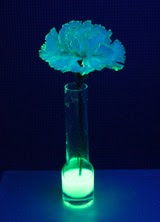Experiments you can do at Home
Scientific experiments do not need to happen in fancy laboratories. Exploring science can happen at home using inexpensive supplies.
Oobleck
Oobleck is a non-Newtonian fluid that behaves unlike other fluids. Flowing freely, it behaves as a regular liquid, but when a force is applied, it is more like a solid. If you pick oobleck up with your hands, it will easily flow through your fingers. If you squeeze or punch it, it will resist and feel like a solid. In large enough quantities, you can even walk on it! Oobleck can also dance to music, when spread out onto a sheet pan or plastic wrap and placed over a subwoofer. The pressure from the sound waves causes it to thicken as it moves.
- 1 part water
- 2 parts cornstarch
- Drops of food coloring (there are a few options with this)
Combine ingredients and stir. That's it. The food coloring can added in a few different ways. Adding it at the beginning with the rest of the ingredients to create a uniform color. Small amounts of prepared oobleck can be differently colored. When combined, they can add additional exploration in primary and secondary colors. The third option might be the most fun: make it dance together. When plain oobleck is placed over the subwoofer, drops of food coloring can be placed on the surface. When the sound is turned on and the oobleck starts to dance, the colors will mix and swirl together.
Oobleck is nontoxic, but does get messy.
Precipitation in a Jar:
Exploring precipitation at home is quite easy.
For this experiment, you will need:
- 200 ml (1 cup) Hot, but not boiling, water
- Tall glass jar
- Glass plate
- Ice cubes
Pour the hot water into the clear glass jar and immediately cover with the plate. Wait a few moments for the steam to build up in the jar, then place ice cubes on plate. Warm air can hold water in the gas phase better than cold air, so as the vapor cools, the water will condense and “rain” down into the jar.
DNA Extraction
DNA can be extracted and examined quite easily. If you don’t have dried peas, strawberries or bananas make an excellent choice.
For this experiment, you will need:
- 100 ml (½ cup) plant source of DNA
- Less than 1 ml (⅛ teaspoon) table salt
- 200 ml (1 cup) cold water
- Enzymes (meat tenderizer or contact lens solution will work well)
- 30 ml (2 tablespoons) liquid dish detergent
- 70-90% isopropyl or ethyl alcohol
- Blender
- Strainer
- Glass bowl
- Test tubes
- Wooden skewers or straws
To begin, you will need to choose the source of DNA. Bananas, strawberries, and split peas work well.
Add the plant material, salt, and water to the blender. Blend at the highest setting for 15-20 seconds. Strain the contents over the bowl, and add the detergent. Allow the mixture to rest for 10 minutes. Next, divide into test tubes, each no more than ⅓ full. Add a pinch of enzymes to each tube and very gently stir to combine. Alcohol can be added to each test tube, matching the volume of the plant mixture. The white precipitate between the layers is the DNA! It can be extracted with a clean wooden skewer and examined under a microscope, or placed in alcohol for safekeeping.
Unpoppable bubbles
Industrial strength bubbles that resist popping are easy to make.
For this experiment, you will need:
- 1.4 liters (6 cups) distilled water
- 235 ml (1 cup) light corn syrup
- 470 ml (2 cups) regular strength Joy liquid dish soap
- Large bowl
- Bubble wands
Slowly stir the ingredients together in the bowl, as to not form bubbles. Allow the solution to rest for 24 hours. Dip the wands into the solution and blow super strength bubbles!
Note: Minerals found in regular tap water can affect the performance of these bubbles, making the use of distilled water incredibly important.
Glow in the Dark Bubbles
Bubbles that glow can be created by adding glow in the dark paint to an existing bubble solution. The paint might affect the integrity of the unpoppable bubbles, so they might not be as resilient if you combine the paint to that solution.
For this experiment, you will need:
- Bubble solution
- Glow in the dark paint in any color
- Bowl
- Bubble wands
Combine one part bubble solution to one part glow in the dark paint. If the bubbles don’t maintain their form, add more bubble solution.
Note: Glow in the dark paint is preferred over the contents of a glow stick, as some glow stick solutions are toxic and pose a health or environmental hazard. It also really messes with the consistency and won't produce nice, glowing bubbles.



Comments
Post a Comment